
Dillwynia tenuifolia is a species of flowering plant in the family Fabaceae and is endemic to eastern New South Wales. It is an erect shrub with linear leaves, and orange-yellow and red flowers.

Lechenaultia linarioides, commonly named yellow leschenaultia, is a species of flowering plant in the family Goodeniaceae and is endemic to near-coastal areas in the west of Western Australia. It is a sprawling subshrub with many tangled branches, narrow, crowded, rather fleshy leaves, and yellow and deep pink to purplish red flowers.

Sambucus gaudichaudiana, commonly known as white elderberry, is a species of flowering plant in the family Adoxaceae and is endemic to eastern Australia. It is a perennial shrub but with stems that are produced annually with pinnate leaves that have three to eleven leaflets, small white flowers and small but edible fruit. It grows in cool forest and shady gorges.
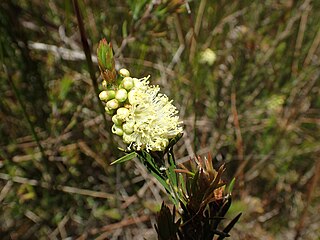
Melaleuca paludicola, commonly known as river bottlebrush, is a plant in the myrtle family Myrtaceae, and is endemic to eastern Australia. It is a shrub or small tree with flexible, often drooping branches, pinkish new growth and spikes of cream, pale yellow, or sometimes pink flowers in summer.
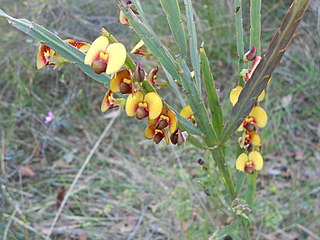
Bossiaea ensata, commonly known as sword bossiaea, is a species of flowering plant in the family Fabaceae and is endemic to south-eastern continental Australia. It is an erect or low-lying, glabrous shrub with flattened branches, flattened, winged cladodes, leaves mostly reduced to small scales, and orange-yellow and red flowers.
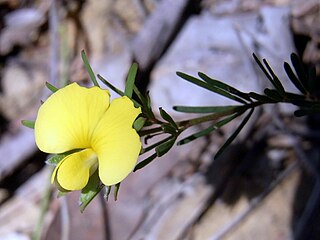
Gompholobium glabratum, commonly known as dainty wedge-pea, is a species of flowering plant in the family Fabaceae and is endemic to south-eastern continental Australia. It is a low-lying or ascending shrub with pinnate leaves that have five to seven leaflets, and yellow and green or greyish flowers.
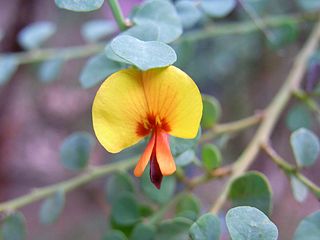
Bossiaea rhombifolia, is a species of flowering plant in the family Fabaceae and is endemic to eastern Australia. It is an erect, glabrous shrub with diamond-shaped, more or less round or broadly egg-shaped leaves, and yellow and red or pinkish flowers.

Dillwynia acicularis is a species of flowering plant in the family Fabaceae and is endemic to New South Wales. It is an erect shrub with linear, grooved leaves and yellow flowers with red markings.

Dillwynia rudis is a species of flowering plant in the family Fabaceae and is endemic to eastern New South Wales. It is an erect shrub with warty, linear leaves and yellow to orange flowers with red veins.

Pultenaea echinula, commonly known as curved bush-pea, is a species of flowering plant in the family Fabaceae and is endemic to a small area of New South Wales. It is an erect shrub with linear, needle-shaped, grooved leaves, and dense clusters of yellow to orange and red flowers.

Pultenaea euchila, commonly known as orange pultenaea, is a species of flowering plant in the family Fabaceae and is endemic to eastern Australia. It is an erect shrub with glabrous foliage, narrow egg-shaped leaves with the narrower end towards the base, and orange-coloured flowers arranged singly or in small groups near the ends of branchlets.

Bossiaea lenticularis is a species of flowering plant in the family Fabaceae and is endemic to eastern New South Wales. It is a slender, spreading shrub with mostly circular leaves, and yellow and red flowers.
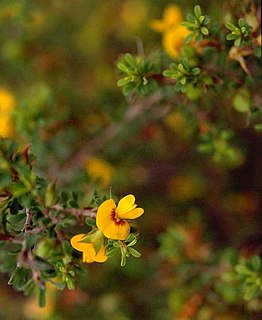
Pultenaea parviflora, sommonly known as Sydney bush-pea, is a species of flowering plant in the family Fabaceae and is endemic to eastern New South Wales. It is usually a small, erect shrub with wedge-shaped to narrow egg-shaped leaves with the narrower end towards the base, and clusters of yellow to orange and red flowers.

Gompholobium virgatum, commonly known as leafy wedge pea, is a species of flowering plant in the family Fabaceae and is endemic to eastern Australia. It is a erect or sprawling shrub with trifoliate leaves, the leaflets narrow egg-shaped with the narrower end towards the base, and yellow and greenish, pea-like flowers.
Pandorea floribunda is a species of flowering plant in the family Bignoniaceae and is endemic to eastern Australia. It is similar to Pandorea pandorana but the leaflets are egg-shaped, 30–80 mm (1.2–3.1 in) long and 15–50 mm (0.59–1.97 in) wide and the flowers are pale yellow to cream-coloured.

Bauera capitata is a species of flowering plant in the family Cunoniaceae and is endemic to coastal eastern Australia. It is a small shrub with trifoliate, usually lobed leaves and sessile, deep pink flowers with twelve to fifteen stamens.
Olearia cydoniifolia is a species of flowering plant in the family Asteraceae and is endemic to eastern Australia. It is a shrub with scattered elliptic leaves, and white and yellow, daisy-like inflorescences.

Sprengelia monticola, commonly known as rock sprengelia, is a species of flowering plant of the family Ericaceae, and is endemic to the Blue Mountains in eastern New South Wales. It is an open or low-lying shrub with egg-shaped to lance-shaped leaves, and white flowers arranged singly in leaf axils.

Olearia quercifolia, commonly known as oak-leaved olearia, is a species of flowering plant in the family Asteraceae, and is endemic to the Blue Mountains in New South Wales. It is a shrub with elliptic to egg-shaped leaves with the narrower end towards the base, and white and yellow daisy flowers.
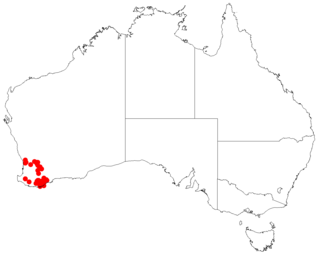
Leucopogon cymbiformis is a flowering plant in the family Ericaceae and is endemic to the south-west of Western Australia. It is a bushy or wiry shrub that typically grows to a height of 30–50 cm (12–20 in) and has more or less glabrous branches. Its leaves are erect, linear to lance-shaped and sharply-pointed, mostly 2–4 mm (0.079–0.157 in) long. The flowers are arranged in short spikes, sometimes of only two or three flowers, with lance-shaped, leaf-like bracts, and bracteoles half as long as the sepals at the base of the spikes. The sepals are 2.5–3.0 mm (0.098–0.118 in) long and the petals slightly longer than the sepals, the lobes shorter than the petal tube.




















